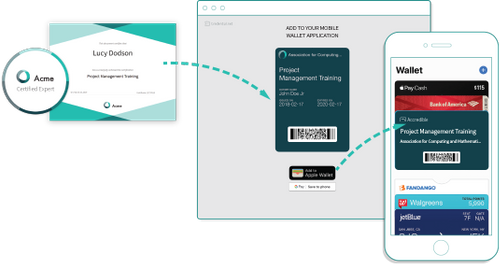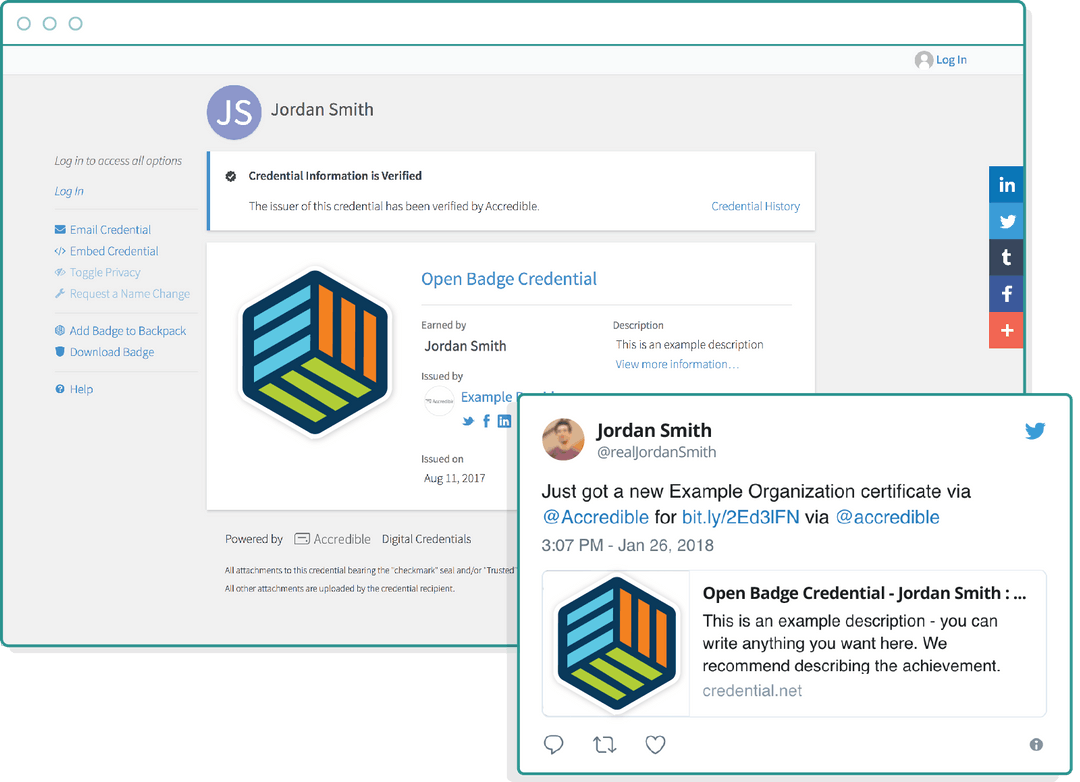Digital credentials are issued in two formats, digital certificates and digital badges. There are no restrictions on when a digital certificate or digital badge should be issued. The versatility of digital credentials enables their use across a huge variety of applications. From representing event attendance and rewarding sponsors or speakers, to recognizing study efforts and awarding passing marks on an exam.

Digital credentials in higher education are growing in popularity as an educational technology. Learners see the digital credentials earned by their peers through other institutions and online learning environments, and want the benefits of digital credentials for their own career development.
When to use a digital badge for students?
Digital badges from Accredible follow the Mozilla Open Badge standard. This means the digital badge is embedded with meta information, including details about the skills and achievements earned by the recipient. The digital badge image can be downloaded and verified, and is fully shareable and portable. As digital badges can be embedded with any information, they can be used to represent any type of award or achievement.

Digital badges are more visual and less formal than digital certificates. As a result, issuers tend to use digital badges for awards that require less time or effort to earn. This includes:
- Individual modules of a program
- Sections or levels within a broader course
- Passing an automated or unmarked quiz
- Showcasing soft skills
- Representing micro-credentials
Some issuers choose to issue a digital badge alongside a digital certificate. This provides their recipients a formal digital certificate and an easy-to-embed digital badge image that can be added to email signatures.
When to use a digital certificate for students?
Digital certificates from Accredible can be designed for use both online and offline through the inclusion of QR-codes into the certificate design. Once a digital certificate has been issued to the recipient, a QR-code is generated on the design that provides an easy-to-scan link back to the live certificate hosted online. This gives recipients the freedom to have their certificate printed professionally, or print it from home to display in their office or add to their professional development portfolio. Recipients can present their physical certificate in interviews or review sessions. Third-parties can easily scan the certificate to review and verify the live digital credential.

Digital certificates are more formal in their appearance and their use. Issuers commonly use digital certificates for achievements and awards that require a lot of time or effort to earn. This includes:
- Achieving passing marks for a long-term program (40+ hours)
- Completing a full higher education course (part-time or full-time)
- Passing a proctored or assessed exam
- Completing an internship (6 months+)
The benefits of digital certificates and digital badges for students
Digital credentials are more than the modern equivalent of traditional awards and certificates, they provide a number of key benefits to recipients and issuers. They allow for gamification of the student learning journey, motivating candidates to reach the end of their program or course. They save administration time for creating, issuing, and managing credentials and help to reduce material spend. They are also received instantly, which eliminates the wait time for recipients. We frequently receive positive feedback on the portability, shareability, longevity, and verifiability of digital credentials.
Portability

Recipients can upload their digital certificates or digital badges to digital wallet cards and apps on Apple and Android smartphones. This allows them to present their digital credential on-the-go, in an interview, on a job-site, or during an employee review. Their educational proof is always available from their device to provide verifiable evidence of their accomplishments. Earners can upload any number of digital credentials to their digital wallet for easy retrieval in seconds.
Shareability

Recipients share their digital credentials to their preferred social media networks including Facebook, Twitter, and LinkedIn. They can share and celebrate their achievement in one-tap from the digital credential page with their friends, family, colleagues, and peers. Recipients can upload their digital credentials to their LinkedIn profile where it can be seen, searched, and reviewed by third-parties including hiring managers and recruiters, improving their employment prospects. The detail enabled by the use of digital credentials allows recipients to showcase their learning experience. This includes evidence of their demonstrable skills including specific skills added as searchable skill tags, and accompanying documents to show exam results, report cards, or dissertation scores. All of which can be viewed when engaging with the shared credential.
Longevity
Recipients want assurance that their career-advancing credentials are protected long-term. Should their educational institution close or undergo a merger, they want to know that their achievements still hold value and can be verified without issue or delay. Digital credentials remain live even if the issuer is no longer active or available and can still be verified as long as it is valid and has not passed a given expiration date.
Verifiability
Verification of a credential can delay processes or in extreme cases, lead to a loss of opportunity for the individual. Digital credentials can be verified in one-click from the live credential page, providing peace of mind for credential holders. If a digital certificate has been designed with a QR-code ready for printing, the physical certificate can still be verified easily by scanning the QR-code with a smartphone. This links to the live credential where third-parties can then view the full credential details and click to verify the award.
In Summary
World-wide adoption of digital credentials is the next step in edtech. Learners are starting to show preference towards programs that offer digital credentials over those offering traditional awards or PDF certificates. They see their peers, colleagues, and friends earning digital credentials and the employment or learning opportunities this provides, and they want the same for themselves. Issuers are turning to digital certificate and digital badge platforms to deliver digital credential programs that:
- Incentivize and motivate their students
- Reduce the time and cost of credentialing
- Increase the visibility of programs and credentials
- Meet the demand for secure shareable awards
For more information on launching your own digital badging program, creating and issuing digital certificates, or how Accredible can help you grow your programs through digital credentials, book a demo with our team today.







